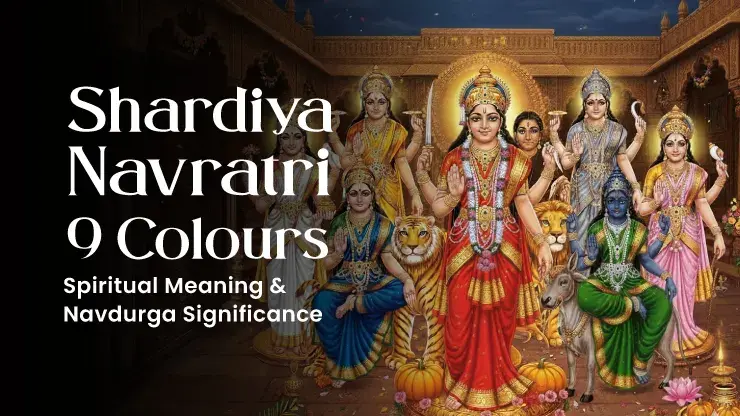Shardiya Navratri 9 Colours: Spiritual Meaning & Navdurga Significance

From the Garba nights of Gujarat to the Durga Puja pandals of Bengal, Navratri is celebrated with devotion and joy across India. The essence of this festival is the worship of Goddess Durga in her nine forms, each radiating a unique energy and blessing. One of the most cherished traditions is the practice of following the Navratri 9 colours, where every day is dedicated to a specific shade that reflects the goddess being honoured.
The significance of Shardiya Navratri colours goes beyond appearance, they symbolise purity, strength, wisdom, compassion, and every divine quality that Durga represents. Wearing these colours or surrounding ourselves with them during rituals is believed to bring harmony, positivity, and the blessings of the goddess.
During Shardiya Navratri 2025, families, communities, and entire cities come alive with coordinated colours, people dress in them, decorate their homes, and even plan celebrations around the day’s shade, turning devotion into a vibrant expression of faith. These colours also carry an astrological connection, aligning with planetary energies that influence our emotions, mindset, and spiritual growth.
In this guide, we’ll take you through the nine days of Navratri, their colours, the navdurga they represent, and the energy each one channels, along with the spiritual and astrological meaning behind them.
Understanding The 9 Colours of Navratri and What They Mean
Each day of Navratri is carefully tied to a form of Maa Durga, a colour, and the unique energy that the goddess represents. These shades are part of how we live the festival, from the clothes we wear to the decorations in our homes. And if you’ve ever wondered why the colours matter so much, here are the details listed below.
Day 1 – White (Maa Shailputri)
Navratri begins with the worship of Maa Shailputri, the daughter of the mountains and the first form of Durga. Her calm and grounded energy shines through the colour white, symbolising peace, purity, and fresh beginnings. Devotees wear white to invite serenity into their homes and hearts.
Astrologically, Maa Shailputri is connected with the Moon, which rules emotions and mental balance. Beginning Navratri with white stabilises thoughts and prepares the mind for the spiritual journey ahead. Many also decorate their puja area with white flowers, cloth, or rice as offerings to the goddess.
Day 2 – Red (Maa Brahmacharini)
The second day honours Maa Brahmacharini, known for her unwavering devotion and discipline. The colour red mirrors her energy of strength, courage, and passion. Devotees wear red to feel empowered and focused during prayers and rituals.
In astrology, she is linked with Mars, the planet of action and determination. Wearing red on this day is believed to awaken inner strength, fuel devotion, and help overcome obstacles. Red flowers and offerings are commonly used to honour her presence.
Day 3 – Royal Blue (Maa Chandraghanta)
Maa Chandraghanta is worshipped on the third day, and her colour is royal blue, reflecting bravery, calm, and resilience. Wearing blue aligns devotees with her protective energy and encourages courage in facing challenges.
Astrologically, she is associated with a balanced planetary energy that enhances focus, inner strength, and clarity of thought. Blue decorations or garments on this day symbolise the courage to confront negativity while staying composed.
Day 4 – Yellow (Maa Kushmanda)
The fourth day belongs to Maa Kushmanda, the goddess of cosmic creation. Her colour is yellow, representing joy, vitality, and abundance. Devotees wear yellow to invite positivity and creativity into their lives.
Astrologically, Maa Kushmanda is linked with the Sun, enhancing energy, confidence, and clarity. Yellow flowers, fruits, or cloth are commonly offered to honour her. Embracing this colour allows devotees to feel radiant and connected to the goddess’s creative power.
Day 5 – Green (Maa Skandamata)
Maa Skandamata is celebrated on the fifth day, and green is her colour. It symbolises growth, nurturing, and harmony, especially within the family. Wearing green helps devotees connect with her motherly energy and compassion.
Astrologically, she is associated with Mercury, the planet of wisdom and communication. Green decorations, leaves, and clothing are commonly used to honour her. Wearing this colour brings balance and strengthens bonds with loved ones.
Day 6 – Grey (Maa Katyayani)
The sixth day is dedicated to Maa Katyayani, known for her courage and power. Her colour, grey, reflects balance, resilience, and transformation. Devotees wear grey to align with her determined and protective energy.
Astrologically, Maa Katyayani is connected to Jupiter, enhancing strength, courage, and wisdom. Grey flowers or cloth are offered during rituals, helping devotees channel their energy and stay grounded during spiritual practices.
Day 7 – Orange (Maa Kalaratri)
On the seventh day, Maa Kalaratri is worshipped in orange, the colour of energy and enthusiasm. She removes fear and negativity while protecting devotees, and orange helps reflect her fierce yet nurturing energy.
Astrologically, she is tied to Saturn, guiding discipline, karma, and inner strength. Wearing orange on this day is believed to shield one from negative energies and enhance courage during spiritual and personal challenges.
Day 8 – Peacock Green (Maa Mahagauri)
Maa Mahagauri, worshipped on the eighth day, is linked with peacock green, symbolising freshness, renewal, and purity. Devotees wear this colour to feel calm, compassionate, and spiritually uplifted.
Astrologically, she is connected to Rahu, balancing energies that support inner peace and detachment from material worries. Peacock green decorations and attire are common, helping devotees align with her serene energy.
Day 9 – Pink (Maa Siddhidatri)
The ninth and final day is dedicated to Maa Siddhidatri, who grants blessings and spiritual fulfilment. Her colour, pink, reflects love, kindness, and devotion. Wearing pink invites her grace and abundance into daily life.
Astrologically, she is connected with Ketu, the planet of spirituality and liberation. Devotees offer pink flowers or garments while seeking her blessings, ending Navratri on a note of divine love, completion, and spiritual achievement.
Cultural Practices and Regional Variations of Navratri in India
The nine-day Navdurga festival is celebrated with unmatched energy in India, where each region brings its own unique customs and rituals to the festival. The colours of Navratri go beyond just decoration. They bring people together, connect everyone to the goddess and to each other. This turns the festival into a shared experience full of joy and devotion.
Regional Observances: Celebrating Navratri in Unique Ways
Across India, Navratri manifests in fascinatingly different ways. In Bengal, Durga Puja features elaborately decorated pandals and rituals that last for days, where people gather to admire the artistry and seek blessings. In Gujarat, Navratri is synonymous with Garba nights, where communities come together in dance circles around images of the goddess, wearing outfits that match the Navratri days' colour of that day.
In the South, households focus on fasting, home pujas, and decorating small shrines, emphasising discipline, devotion, and family bonding. Despite these differences, the underlying theme is consistent: the significance of Shardiya Navratri colours is observed in every practice, helping devotees align with the energy of the goddess being worshipped.
Kanya Puja: Honouring the Divine in Young Girls
One of the oldest traditions followed on the last day of Navratri is Kanya Pujan. It is observed on the eighth or ninth day. Young girls, symbolising the goddess herself, are worshipped with flowers, food, and gifts. Devotees often dress in the day’s specific shade, reflecting the colours of Navratri, and offer prayers that emphasise purity, respect, and gratitude.
Homes and Communities: Living the Festival
Even in smaller towns or villages, Navratri is celebrated with zeal. People decorate homes with bright fabrics, rangoli, and lights, often following the Shardiya Navratri colours for each day. Families plan meals, prayers, and community gatherings around these colours, creating continuity and connection throughout the nine days.
The use of colour in homes and streets transforms everyday spaces into sacred arenas, helping devotees feel the energy of the goddess and keeping alive a centuries-old tradition that brings together faith, culture, and community.
Beyond the Colours: Astrology and Spiritual Energy of Navratri 2025
The nine-day Navratri festival carries a unique astrological significance, which is associated with different colours. Each of them helps you align your energy with the planetary forces associated with the goddess being worshipped. Wearing the right shade can enhance qualities like courage, calmness, wisdom, and compassion, making the festival a spiritual as well as a devotional journey.
- Colours reflect the energy of the goddess being worshipped and help devotees align with her qualities.
- Each shade resonates with planetary influences in Vedic astrology, enhancing mental clarity, emotional balance, and spiritual focus.
- Wearing the right colour amplifies the positive energy in homes, puja spaces, and community gatherings.
- The practice encourages mindful devotion, turning rituals into a personal journey of alignment with divine and cosmic energies.
- Observing the festival with these colours promotes a harmonious blend of tradition and astrology, connecting communities and families through shared spiritual experience.
Conclusion: Harmonise Devotion and Cosmic Energy
As we wrap up the guide to colours, it’s your time to turn each day of Navratri into a more meaningful and spiritually enriching experience. Observing the significance of Navratri colours helps you connect deeply with the goddess’s energy, while following the Shardiya Navratri colours allows you to align your own energy with cosmic forces for balance, positivity, and inner clarity.
If you want to know which colour of Navratri today best suits your energy or seek personalised guidance, you can consult trusted astrologers and explore detailed rituals, insights, and predictions on the Neo Astro App, making every day of Navratri truly transformative.
FAQs - Significance of Navratri Colours
Why are specific colours assigned to each day of Navratri?

Each day of Navratri corresponds to a different form of Goddess Durga, and the colour reflects the energy or quality that the goddess represents. Wearing the right colour is believed to enhance that energy in your life, helping with positivity, focus, and spiritual alignment.
Do I have to wear the assigned colour strictly?

Not necessarily. While wearing the day’s colour is considered auspicious, the essence lies in mindful devotion. You can wear variations of the colour or incorporate it in accessories or decorations if a full attire isn’t possible.
How do Navratri colours connect with astrology?

Every colour resonates with certain planetary energies in Vedic astrology. For instance, white aligns with the Moon, promoting calmness and clarity, while red aligns with Mars, enhancing courage and determination. Following the colours can help you feel more in sync with cosmic energies.
Can anyone follow the colour schedule at home?

Absolutely. The practice is not limited to public celebrations. Even at home, wearing or decorating according to the daily colours can create a devotional and spiritually uplifting atmosphere for family and oneself.
What if I miss wearing a particular colour on a day?

It’s okay. The intention and devotion matter more than the colour itself. You can continue following the remaining days’ colours and maintain your spiritual connection with the goddess.
How can Neo Astro help me with Navratri colours?

Neo Astro provides insights into which colour of Navratri today aligns with your energy, along with detailed explanations of the goddess, planetary influences, and rituals. You can also consult trusted astrologers for personalised guidance to make each day spiritually meaningful.
Do Navratri colours have benefits beyond tradition?

Yes, they do. Wearing or surrounding yourself with the assigned colours can influence your mood, energy, and focus, supporting emotional balance and a positive mindset while deepening your spiritual practice.
